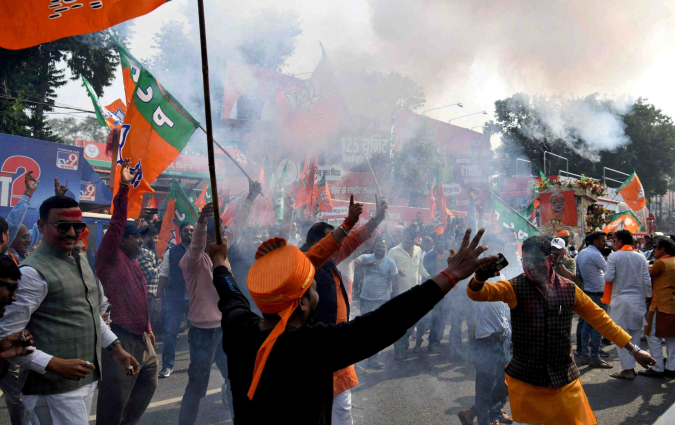Our podcast: Digital News Report 2021. Episode 3: Perceptions of fair news coverage among different groups

Read this year's Digital News Report here.
The topic
This episode of our Digital News Report 2021 podcast series focuses on findings around perceptions of fairness among different groups including demographic characteristics and political leaning.
The speakers
Richard Fletcher is a Senior Research Fellow at the Reuters Institute, and Team Leader of the Research Team. He is primarily interested in global trends in digital news consumption, comparative media research, the use of social media by journalists and news organizations, and more broadly, the relationship between technology and journalism. He authored the DNR 2021 chapter on perceptions of fairness in news coverage.
Our host Federica Cherubini is Head of Leadership Development at the Reuters Institute. She is an expert in newsroom operations and organisational change, with ten years of experience spanning major publishers, research institutes and editorial networks around the world.
The podcast
The transcript
On perceptions of fairness ↑
Federica: Diversity is now a key priority for many newsrooms across the world. And although improving, diversity has been a decades-long process for some news organisations. The political shocks like the election of Donald Trump in the US, Brexit in the UK prompted some to ask whether newsrooms primarily staffed by relatively wealthy, urban, liberal-minded journalists, could ever really understand people who think, vote and live differently from them. In the last year also, the topic has been reignited by the Black Lives Matter protest coupled, for example, with claims made by Megan Markle in a high profile interview with Oprah Winfrey and that has sparked an additional debate and we’ve seen especially in the UK. So all this prompting the critical examination of how the news media handles race and ethnicity.
So, Richard, to better understand how audiences think about how the news media cover people like them, this year you asked in the report – you asked in the survey our respondents whether they think the news media covered people like them fairly or unfairly. What did you find out? And because this is a particularly nuanced topic, can you explain to us how you approached this question?
Richard: Yes. So we wanted to know more about how people perceived news coverage of people like them. And rather than ask this in a general sense, we asked people a series of questions about specific topics. So whether they think the news media covers their political views, people their age, people their gender, their ethnicity, where they live and so on – either fairly or unfairly. And then we used this data to compute what we’ve called a “net perceived fairness score” for different groups. So this is simply the proportion within that group that responded unfairly subtracted from the proportion that responded with fairly. And this is similar to how some approval ratings are calculated for politicians.
So, to give you an example, if 30% of under 35s said that the news media covers people their age fairly but 20% said unfairly; the net perceived fairness score for under 35s would be 10. And you can see from this that if the proportion that responded with unfairly was larger than the proportion that said fairly then the score would be negative.
It’s worth keeping in mind that a significant minority replied to these questions about news coverage with “don’t know” and that’s because some people basically don’t pay enough attention to the news media to have a specific view on different aspects of coverage. That’s worth keeping in mind. And also worth keeping in mind – and perhaps more importantly – it’s worth remembering that what we have data on here is people’s perceptions. So this isn’t data on the actual character or nature of the coverage itself. People might perceive unfair coverage as fair or vice versa. But, of course, at the same time people’s perceptions are real and might still have consequences for people’s attitudes and behaviours around news.
So looking at the actual results, we found that in many countries one of the clearest fault lines was people’s perceptions of news coverage of their political views. So, in short, political partisans are often more likely to think that the news media covers their political views unfairly. That’s particularly true with those who self-identify with the political right. The perception is particularly strong in a country like the US where the net perceived fairness score for those on the right is -59. But if we look at those on the left, it’s actually +17. So what this means is that, on the whole, people on the right tend to think that their political views are covered unfairly by the news media but, for those on the left, they mostly think that they’re covered fairly.
Interestingly though, in the UK, it’s quite different. So here people on the left are actually more likely to say that the news media covers their views unfairly. So it’s not a consistent picture across all the 46 markets that we look at.
On demographic differences in perception of fairness ↑
Federica: So this is for politics and the political leaning. Did you pick up any differences between perception between women and men and how they are covered in the news?
Richard: Yes. So in most markets, what we see is that both men and women tend to say that the news media covers people like them fairly. But across all 46 markets in the report, there is an eight point gap between men and women with women less likely to say that the news media covers them fairly.
Federica: And what about age groups? You mentioned in the example before the under 35s. What findings do you have for age groups?
Richard: Yeah. So actually these overall figures that I just mentioned are actually masking some further differences by age. So if we look instead at younger women – that’s those aged under 35 – the net perceived fairness ratings are actually much lower. And in some countries, among women aged 18-24, the scores are actually negative meaning that they’re more likely to think that they are covered unfairly than fairly.
Federica: We mentioned at the beginning of the podcast how much the topic of race and ethnicity has been particularly the centre of attention in the past year. What does the research say about this specific aspect?
Richard: Yeah. As you mentioned at the beginning, this has clearly been an important topic in the last year. And if we focus on the US – which I think in some ways has been at the centre of the debate – we do see quite clear differences between how black Americans, Hispanic Americans and white Americans think the news media covers people like them. So, in short, while white Americans think that the news media covers people like them fairly on the whole, both black Americans and Hispanic Americans say the opposite with their net perceived fairness score of -13 in both cases.
On regional differences ↑
Federica: In the report, you also talk about how different geographic regions perceive the coverage of their area being unfair. What can you tell us about that?
Richard: That’s right. For this, we looked at the UK, the US and Germany. And we do see some differences between perceived fairness scores between different regions within those countries. So, in the UK, people are more likely to think that where they live is covered fairly by the news media if they live in London and the South of England. Whereas, if you look at Germany, some of the Eastern German states – people are actually less likely if they live in these states to think that where they live is covered fairly as compared to the rest of Germany. And in the US, attitudes towards the news media coverage are more positive among people who live on either the East coast or the West coast. But if we look at people who live further inland then the attitude starts to cool and the net fairness ratings are lower.
On reasons behind the differences ↑
Federica: This is so interesting. You mentioned at the beginning there are many different reasons for people thinking – and this is about asking people’s perceptions – so many different reasons for thinking of people – their age, gender, political views, geographic region – are covered fairly or not. Have you found any possible factors that you can explain to us as influencing this perception of fairness?
Richard: Yeah. I think it’s a complex picture and I think there are likely to be many different factors at play and these will be different depending on which aspect of news coverage you look at. I think this is something we want to look at in the future in more detail. But one factor that we did look at this year that seems to be important is the perceived volume of news coverage that different topics get. So if people think that a specific aspect of their lives – including some of those I mentioned earlier – does not receive enough news coverage then they’re more likely to think it’s covered unfairly compared to if, for example, they think the amount of news coverage something receives is about right. So I think that’s suggesting that the perceived volume of coverage affects whether people think they’re covered fairly or unfairly.
On trust and fairness ↑
Federica: Lastly Richard, I wanted to ask you about if there is a link between the perception of fairness of coverage and the general levels of trust in news? As we’ve seen in this year’s report, that level of trust in news is going up a bit compared to the previous year. Is there a link?
Richard: I think conceptually it seems to make sense that perceptions of fairness in news coverage and trust in the news would overlap. So it’s not surprising that when we actually look at the data there are quite strong links between fairness perceptions and trust with those that think they’re covered fairly more likely to say that they trust most news most of the time. And I think this links back to the point at the beginning about how perceptions – even though they may not accurately reflect the nature of coverage – they can still be important to understand because they might have consequences for something like trust.





